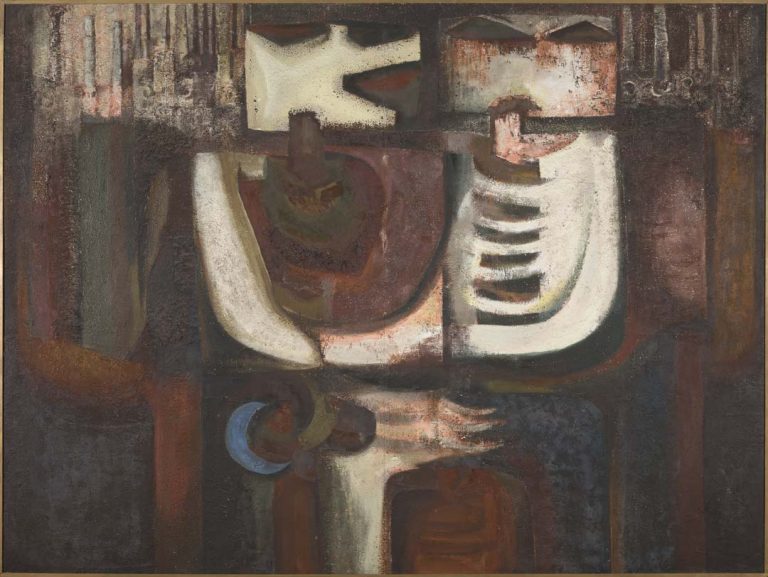We acknowledge the Traditional Owners of the land on which the Queensland Art Gallery | Gallery of Modern Art stands and recognise the creative contribution First Australians make to the art and culture of this country.

Jon Molvig / Australia 1923–70 / Eden industrial: The garden (from ‘Eden industrial’ series) 1961 / Oil treated with blowtorch on composition board / 185 x 246.6cm / Purchased 1983 / Collection: Queensland Art Gallery | Gallery of Modern Art / © Otte Bartzis
Jon MolvigEden industrial: The garden 1961
On Display: QAG, Gallery 12
Jon Molvig’s ‘Eden Industrial’ series explores the artist’s early, and largely unhappy, years growing up in Newcastle, in New South Wales, surrounded by the smelting works, blast furnaces, and chimney stacks of the local steelworks. Eden industrial: The garden is the largest and most imposing work from the group.
Molvig took the universal figures of Adam and Eve from their paradise of the Garden of Eden and placed them in an industrial wasteland. They are symbols of humanity, imprinted on the landscape with their skeletal, X-ray forms, while their Ned Kelly-like masks refer to Australian history and mythology.
The grainy surface of the paint, into which the artist has incorporated sand, enhances the dark, grimy atmosphere of the ‘Eden’. Molvig also used a blowtorch to achieve the blistered and charred effect, a technique he discovered by accident while trying to remove thick layers of paint from composition board.
Jon Molvig was born in Newcastle, Australia, in 1923. After serving in New Guinea and the Philippines during World War Two, Molvig studied art for three years in Sydney, then went on to travel throughout Europe, where he encountered the German and Norwegian expressionists who would significantly influence his work.
From 1955 until his death in 1970, Molvig was based in Brisbane. A complex man, his career was characterised by radical shifts in style. Molvig was also known for his highly considered exploration of technique and the power of his symbolism.
It’s a matter of inventing symbols for what you want to say and putting the symbols down in paint . . . I believe that for every subject you tackle you must invent a new set of symbols and sometimes a new technique to say what you want to say.1 — Jon Molvig
Endnotes:
1 Jon Molvig Interviewed by Hazel de Berg in the Hazel de Berg Collection [sound recording], Hazel de Berg Collection, National Library of Australia, Canberra; DeB 15, June 1961, <http://nla.gov.au/nla.obj-214255022>, accessed July 2019.
Discussion Questions
1. What does the charred and burnt surface of Molvig’s work evoke? Discuss your answer in terms of visual conventions.
2. Why did Molvig incorporate sand into the paint surface?
3. Describe how Molvig represents Adam and Eve. Why has he portrayed them in this way? What is he trying to communicate about our lives?
Classroom Activities
1. Create a collagraph that reflects Molvig’s aesthetic. Use industrial offcuts sourced from Reverse Garbage.
2. Using Photoshop, create a collage from images cut into simplified shapes. Combine your cut-up images with coloured or semi-opaque layers. Print your collage on cartridge paper and work over the surface with charcoal and pastel.